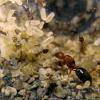Cyphomyrmex rimosus
So yeah, they weren't farming that fungus. They ended up dying, so there goes the Cypho's, again...
Trachymyrmex septentrionalis Colony A
As always, this colony is doing just great, with the fungus taking up all of one chamber and half of the other. They have tons of brood too, and I'd assume they have pupa by now, as I've seen plenty of very large larvae recently. The queen is also laying a ton of eggs all of the time, so that's great!
Trachymyrmex septentrionalis Colony B
So yeah, this colony is doing pretty well too, with the fungus taking up half of the chamber. They appear to have a good amount of brood too from what I've seen.
Trachymyrmex septentrionalis Colony C
Yet another colony, one I did not plan on collecting, but kind of had to. So while I was searching for my lifer Pogonomyrmex badius further southeast in St. Matthews (I succeeded by the way and also got my lifer Dorymyrmex smithi), I had seen a large mound on the surface, but it was very irregular in shape, so I didn't know what it was. I dug my shovel in just to see what was in the mound and, low-and-behold, there was a colony of Trachymyrmex septentrionalis. I didn't want to get another colony, but I saw the queen, so I decided to get it, as it's another population, so why not? I started getting the rest of the colony, and I found another queen, then another, then another, and pretty soon I had 16 queens! The colony has 50 workers in total, so a pretty young colony, but 16 queens!? I have no clue why they would have 16 queens! I've heard that occasionally colonies are polygynous while they're still young, but never to this degree, more like 2 or 3. So yeah, this colony is confusing me.
Camponotus chromaiodes Colony A
So one of my queens finally got her first worker a few days ago, two months and a day after her original capture. I've given them a Dubia roach, and they were pretty quick to take it. I'm going to end up moving them into a 160 millimeter test tube, which will certainly be an upgrade from their current 100 mm tube. The other 4 queens should be getting their first workers in a few days too, though a few of them should've gotten them like a week ago, as it's been well over 2 months.
Brachymyrmex patagonicus Queens
I got a few of these queens during their flights, though I don't really have any use for them. Eh, whatever.
Nylanderia sp. Queens
Got some of these too, and all of them have eggs, some a significant amount. I'd say these are likely N. faisonensis, as it's the most common species in my area, though I'm not entirely certain. I'll wait until workers arrive so I can get a proper ID on them.
Solenopsis invicta Queens
Got some more of these just cause they tend to sell pretty quickly.
Strumigenys louisianae
Finally got another Strumigenys colony! I've moved them into a test tube setup for the time being until I can get them into something better. The colony has around 20 workers, a single queen, plus some alate brood, which is neat.
Aphaenogaster fulva
Well it's been quite a while since I've had a colony of these, since November of 2018. But finally I have another. It's a younger colony, a single queen, around 50 workers, and a pretty nice amount of brood. They're currently nesting in one of my more naturalistic lab nests, and they seem to be taking to it well.
Pheidole bicarinata
So apparently they're already flying? In May? Anyways, I got 2 queens, and they're doing pretty good, both already having eggs.
Aphaenogaster lamellidens
They're recovering from their die-off nicely, and are up to around 30 or so workers with a ton of brood. I gave them some chia seeds too, and they took a few, so at least I know they're eating well.





















